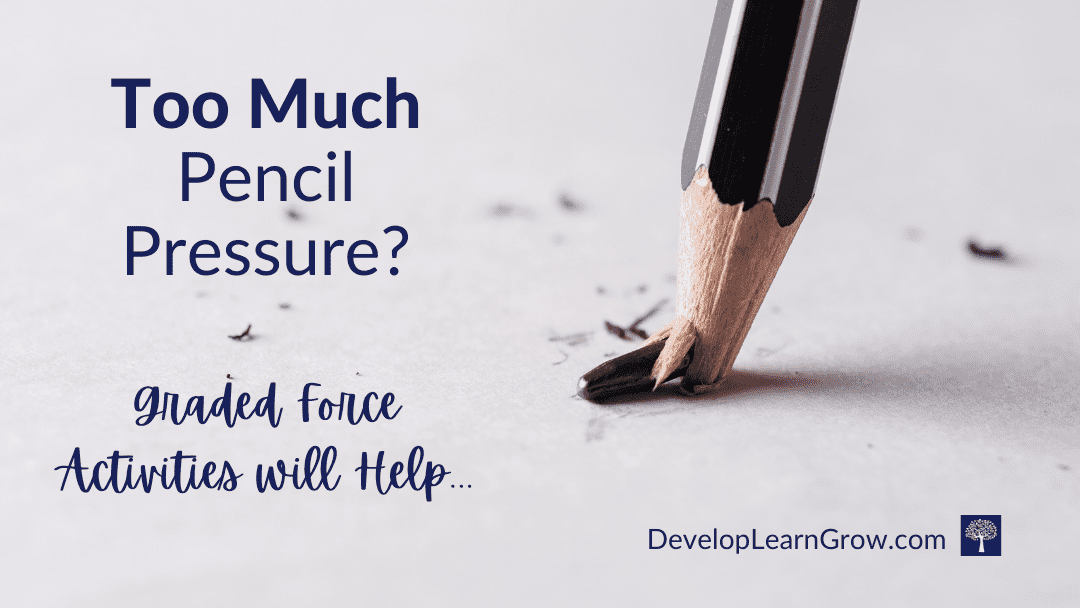Some kids use TOO much pencil pressure during writing tasks. Occupational therapists looks at force modulation and grading of movements in these kids. Graded force activities can help!
Have you ever known a kiddo who constantly breaks their pencil tip when writing because they use too much pressure?
One who writes so dark that they have a hard time completely erasing to make a correction?
Or, maybe they press so hard with the pencil they actually tear through the paper?
I’m sure you have! Many of the students I work with do this.
Why Do Some Kids Use So Much Pencil Pressure When Writing?
Some kids use excessive pencil pressure when writing. They may do this when first focusing on forming letters and numbers. And then it improves.
But other kids continue to use too much pencil pressure for years.
They may even squeeze the pencil really hard when they write. (Which can lead to muscle fatigue, frustration, and even sores on their fingers.)
These kids may also rip a piece of paper when trying to remove it from a notebook. Or, they frequently slam things and break things. But not on purpose!
The reason for all of this?
They’re typically having difficulty with sensory processing. They are unable to use the right amount of pressure because of decreased proprioceptive input, motor feedback and force modulation.
Force modulation in occupational therapy can also be referred to as graded force. As an OT I would say, “These students have difficulty grading their movements.”
What is Force Modulation?
Force modulation is the body’s ability to adjust the amount of pressure and the ability to use enough pressure when completing fine and gross motor tasks.

It involves automatically modifying the level of pressure and force from the muscles. This requires smooth, graded control of movements.
It’s used when grasping and picking up items. And when pushing or pulling larger objects.
For example, think of how you pick up a 15 pound kettle bell weight with your hand vs. a light paper grocery bag with chips inside.
You use the same grasp pattern, but a different amount of force is required from your hand, arm and body.
Another example is when you use the pads of your fingertips to pick up an egg vs. picking up the top of a glass jar full of honey.
You know how to gently pick up the egg without breaking it. And you use enough hand strength to pick up the heavier jar.
Your smaller muscles automatically adjust to the weight of objects and force required.
This skill comes from the proprioceptive system within the muscles and joints.
What Activities Can Help Kids Decrease Their Excessive Pencil Pressure and Improve Force Modulation?
Occupational therapists love using proprioceptive activities. Especially graded force activities! They’re specifically great for kiddos who use too much pressure with a pencil.
Giving extra force input to the muscles in the arms and hands increases feedback to the brain. So many kids need this to increase body awareness.
Body awareness helps with the physical interaction with the environment.
In this post, I share activities and therapy ideas that can help with writing and fine motor skills. The activities focus on the upper body.
However, if you’re reading the other posts on the blog, you’ll start to see how important proprioception is for kids!
Be sure to also be incorporating whole body input for your kiddos. Try upper extremity weight bearing activities such as crab walks or wheelbarrow walking.
For more info on this, check out 25 Brain Breaks for Kids: Improve Focus and Attention (free printable) and Calming Deep Pressure Weighted Tools and Activities that Increase Focus.
The activities listed below include exercises to do before writing and fine motor activities as well as adaptations to try during writing.
Force Modulation / Graded Force Activities to Help Decrease Excessive Pencil Pressure When Writing
Prior to writing, engage the hands in a brief proprioceptive exercise to increase awareness:
- Clap hands together (slow, medium, fast)
- Press hands together
- Squeeze fists
- Massage each finger
- Pat legs gently, tap sides of chair with more force from the palms, then slap the top of the desk with more force
- “Create a Thunderstorm Activity” (this activity adds a listening component – click for more details!)
To help kids learn how to write with less pressure:
- Use a pencil on thin tracing paper or newspaper
- Draw or write on a tissue
- Use a mechanical pencil
- Try different writing tools such as gel pens or thin markers
- Place a mouse pad, Styrofoam, or cork board under the child’s paper

[Affiliate links are used below. Develop Learn Grow may earn a small commission with a qualified purchase, at no extra cost to you. Thank you for supporting the time spent on this site.]
To give extra motor feedback for the hand before writing or during writing:
- Write in playdough with a plastic or wooden tool
- Practice drawing or writing on carbon paper
- Place paper on sandpaper, use a pencil
- Use chalk and a small chalkboard
- Add weight to the pencil using dough (or special pencil weights)
- Try pencil grips (The Pencil Grip is my favorite!)
- Place paper on a screen, use a crayon
- Write on a vertical surface (or a slantboard to improve wrist stability)
- Use a vibrating tool when writing
Games that Address Graded Force (for Outdoor Recess, Indoor Recess or Social Breaks!)
- Tongs – use to pick up different sizes and weights of objects (these are strawberry hullers, but they’re my favorite type of tongs for kids!)
- Don’t Break the Ice
- Topple
- Jenga
- Pick-Up Sticks
- Bocce
- Cornhole
Additional Force Modulation Activities for Centers & Hands on Learning
- Pouring and dumping activities – filling different sized containers
- During coloring, use a pencil or the same colored crayons to shade different areas of a picture (light, regular, dark)
- Stack small items such as math manipulatives
- Place marbles on top of golf tees (either in a piece of styrofoam or in a container of putty or molding dough)
- Pass different sizes and weights of balls in a line or to a partner during a brain break (also encourages crossing midline – click the link to check out the post)

Be sure to click on the links to other posts (embedded throughout this post) for more information. Additional related posts that you might find helpful:
Form Letters Properly with These 9 Helpful Tips
107 Hand Strengthening Exercises for Kids
Correct Sitting Posture for Kids – An Important Tip!
How a Vertical Surface and Floor Activities Improve Core Stability – FREE Printable



0 Comments